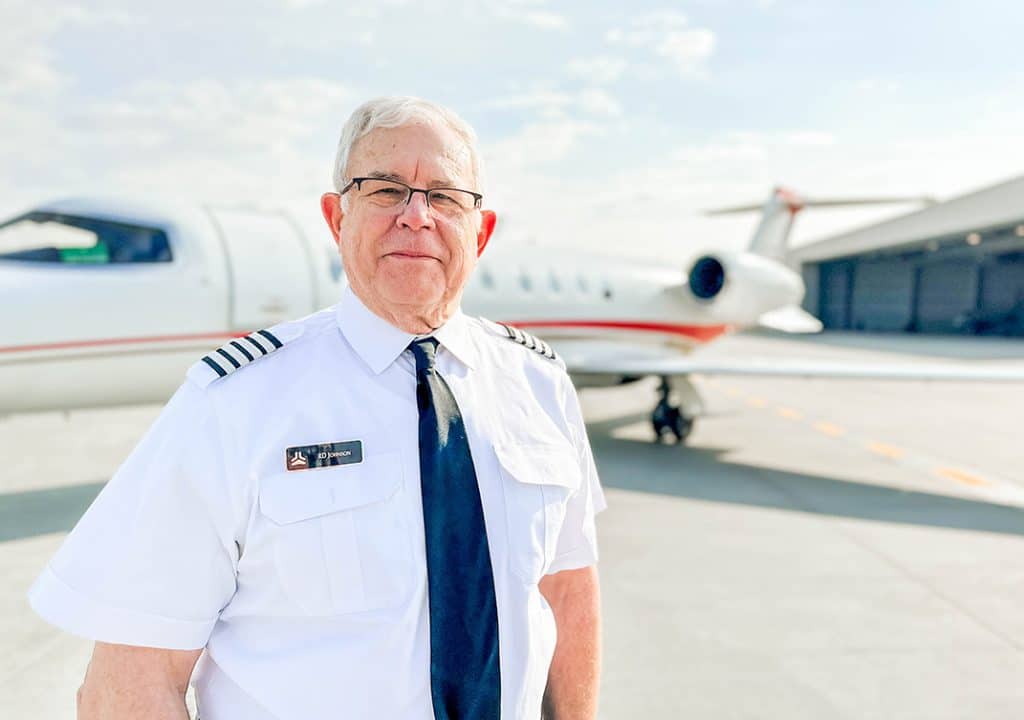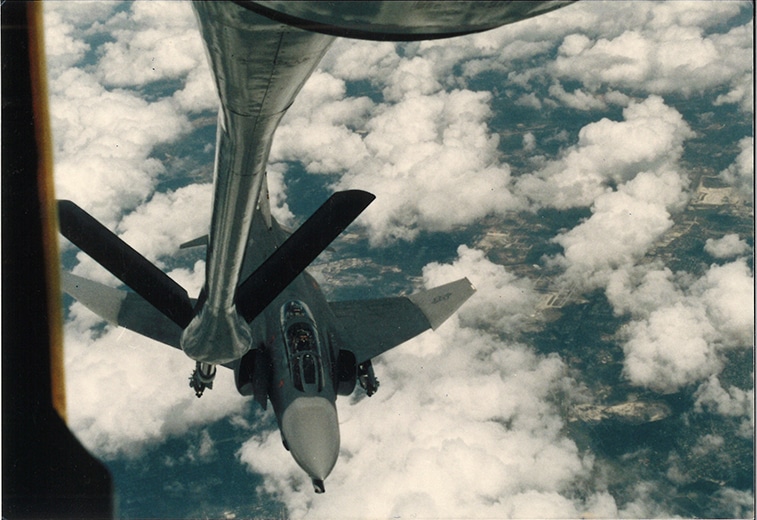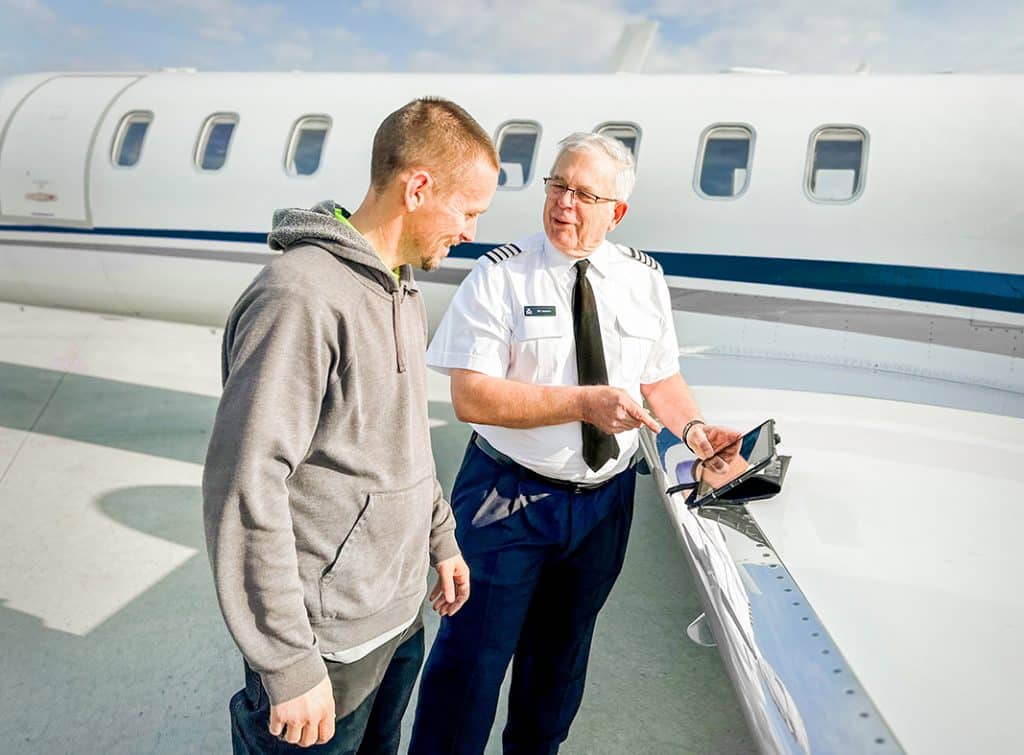Interview with an Aviator: RD Johnson
In the latest installment of Interview with an Aviator, we sat down with RD Johnson, Jet Linx Vice President of Safety.
R. David (RD) Johnson joined Jet Linx in December 2021 as the Director of Safety (now Vice President of Safety) and brings a wealth of Safety Management System (SMS) knowledge as former Director of Safety Management Systems at Global Flight Test and Delivery Group.
As a seasoned aviation professional, Johnson’s experience spans from the flight deck to the classroom. A graduate of the United States Air Force Academy, he retired after 31 years as a Command Pilot flying in the F-4, F-5, F-16, T-38 and served as an instructor in three airframes. He also flew professionally for 14 years with American Airlines. Johnson continues to serve as an instructor at the University of Southern California Aviation Safety and Security School – all while spearheading the Safety department at Jet Linx and piloting for the Company as well.
Johnson is the son of a military medical technician and was practically raised on U.S. Air Force bases. His affinity for aviation came easily, as his father was also a pilot and flight instructor. Now four decades into his extensive aviation career, Johnson seeks to act as a father figure for future aviators and aviation safety professionals.

Tell us about your background.
I was born in San Antonio, TX, in an Air Force hospital. My father had been a medical technician in the Army beginning in World War II, but then transferred to the Air Force when it was created as a separate branch. I am named after his two favorite doctors, one of which who helped with my delivery. Their names were Robert and David, hence ‘RD.’ Right after my birth, my father was almost immediately transferred to Casablanca, Morocco, where we lived for three years. I learned both Arabic and French, so when I came back to the states I spoke a mixture of Arabic, French and English. My parents could understand me, but it was hard for the rest of my extended family at first – it was quite a lingual combination! To this day I can still understand and speak some Arabic but I have mostly lost the French.
My father eventually left the Air Force and worked for the U.S. Post Office and my mother was a federal employee with the IRS in Austin, Texas. I grew up in Austin and back then it was just a quaint university town, and you could get anywhere in 30 minutes no matter which direction. After high school I studied accounting at the University of Texas for two years because it was cheap and convenient for me. I lived at home, had a car, a girlfriend, and a part time job. Then I realized I wanted to get out of the house, so I applied to the United States Air Force Academy.
When I applied, I had to wait quite a while to hear back about my acceptance – and I had to reach out to my congressman, too. When some time passed and I never heard back, I went ahead and resigned from the competition. Very soon after that I got a call from my congressman telling me that he wanted to make me his primary nomination to the Air Force Academy. I told him that’d be a great honor, but I had just sent in a notice to remove myself from the application. He asked if I still wanted to attend the Academy, and when I told him ‘yes,’ I never heard about my application being withdrawn again. By that summer I was on my way to the Air Force Academy in Colorado Springs. The rest is history – and you can probably guess where I got my love for aviation.
I’d say right from the very beginning, in basic training at the Academy, I was hooked on aviation. We got to go up for a ride in a T-33, tandem seating and flew all over the Rocky Mountains west of the Academy with the pilot doing barrel rolls and aileron rolls with views of Pike’s Peak.
Did you have any notable mentors in your career?
I had two distinct mentors in my military career. One was a Lieutenant Colonel, Vanus Bradley. Lt. Col. Bradley gave me a check ride and during the debrief is when I learned good is not good enough. He asked me why I tolerated being 100 feet off my pattern altitude when accomplishing patterns. I told him, well the tolerance is 200 feet. Lt. Col. Bradley told me I was better than that and should strive for five or ten feet. That was a major “aha” moment for me and changed the way I approached flying and decision making.
The next mentor I had was a three-star general, Lieutenant General Stephen Wood. He was a Fighter Weapon School Grad (Air Force version of TOP GUN) and absolutely the best instructor and advisor I ever came across. He had a knack for making junior members of the team and senior members of the team comfortable about bringing up any subject for discussion and then assisting all to become better through his instructional lessons. I wish I was as good as General Wood. He presided over my military retirement ceremony, and it was quite the honor to have an Active-Duty General retiring a Reservist.
Do you have a favorite aircraft to fly? Have you flown any unique models?
My favorite military aircraft was the F-4D Phantom II because of the people and weapons system. It was an impressive fighter, very loud, powerful, and versatile. It was living proof that you could make a rock fly if you attached two good engines to it.
My favorite commercial aircraft is the B-737 – if you understand the systems, you can make it dance. My favorite corporate jet that I have flown is the CJ3+. I like its sophisticated Flight Management System (FMS) – the Garmin 3000. I believe the Garmin FMS is the safest FMS brand to give a pilot situational awareness that is currently in any of our aircraft.
If I could ever pick an airplane to fly, it would be a P-51 Mustang. I thought my wife was going to give me a ride in a P-51 when I retired from the airlines… but maybe she will do that when I retire from Jet Linx. The most unique airplane I have ever flown is a small ultra-light out of Lamesa, TX, where my in-laws live. I helped teach a bunch of farmers to fly, and they could not wait to get me into an ultra-light and scare me to death. One short flight in that airplane was enough for me – way too dangerous. It was like a flying go-kart and as soon as I took off in it, I immediately landed – I was in the air only a matter of seconds. I think the Wright brothers’ initial flight time beat mine in an ultra-light.

What is your best or favorite aviation story?
While in the military, my wife and father were able to take a ‘buddy flight’ in a KC-135 Stratotanker and watch in mid-air as it refueled my F-4 Phantom. I’ll never forget seeing my family watching through the windows of the KC-135 as my fighter was being refilled with 3,000 pounds of fuel per minute, and I was the flight lead, bringing in a line of fighters behind me.
There are also two memorable commercial flights – one was my retirement flight at American Airlines. It was quite emotional and rewarding. I had my whole family on a flight from San Antonio to Dallas, and I had several friends ride with me as well. At the same time, I was checking out the newest Captain at American Airlines, so I got to pass the torch from the oldest pilot to the newest pilot in the organization. That was fun but a little stressful flying with so many loved ones on board.
The other flight came when I was flying private right around my 40th wedding anniversary. I was working for a very generous owner, serving as a pilot of a brand new CJ3+. I asked him when we were on a flight together – what can I give to my wife when I have been married 40 years? That aircraft owner gave me two gifts – one was the idea to write my wife a letter of the best memories we had together and the other was to take the airplane and go for a date anywhere I wanted (I paid for the fuel). So, I secretly planned a 40th wedding anniversary date where my daughter and her husband, my sister and her husband, and my mother all went on a trip. My wife had always wanted to go to Lajitas, TX – so we flew there, did some sightseeing, pool time, horseback riding and a round of golf (one of the top 50 golf courses in Texas). It was a weekend we’ll never forget. These are the kinds of unique opportunities that can only come from the private aviation industry.
Describe your career path before coming to Jet Linx.
After graduating from the Air Force Academy, I went to initial pilot training at Reese Air Force Base in Lubbock, Texas. There was not much there but dirt and cotton and a lot of flying – but I did also meet my future wife, Beth Ann there. From there I went on to fly and instruct in several airplanes – I flew the F-4C Phantom II, the Northrop F-5, F-4D Phantom II, F-4E Phantom II, F-16 Fighting Falcon and the Northrop T-38 Talon in that order. For six and a half years I was active military, and another 25 years with the U.S. Air Force Reserves for a total of 31 years. In that time in the Air Force, I was actively flying for about 20 years and the rest was staff work. When I left active duty, I started at American Airlines where I flew the Boeing 727, Boeing 757/767, McDonnell Douglas MD-80 and the Boeing 737 for more than 34 years before mandatory retirement.
After retirement at American Airlines, I started my Part 135 career through a friend that had a Part 135 company. This friend owned a Lear 45 and a few other airplanes, and I had previously done some consulting for him, helping him with his organization’s safety program. So, he eventually hired me as a Chief Pilot and Safety Director. When I started in that role we had a Wyvern audit, which was my very first experience with Wyvern. I also did a B-737 simulator instructor job for Southwest Airlines for a few months before coming to Jet Linx.

When did you first get involved in aviation safety?
My first experiences with safety began in the Air Force when we were in Nevada doing a wartime exercise. Within the course of a week, we had two accidents that killed four crewmembers in my squadron. A week after this, I became a First Lieutenant Safety Officer, and later as a Senior Officer I was asked if I wanted to be a Safety Board President. This was not necessarily a fun job but it was an important job. We were conducting crash investigations, like what the National Transportation Safety Board does. Around this same time, I was a Fleet Captain at American Airlines where I oversaw 365 aircraft. In 2011, I stopped being a Manager with American Airlines and a Part 142 Group invited me to become their Director of SMS. At this time, I attended the Aviation Safety and Security school at the University of Southern California (USC) where I was subsequently asked to teach. I earned my SMS Certification in 2013 from USC, and that’s when I became serious about safety management.
What has been your favorite part about working for Jet Linx so far?
It’s simple – I like trying to make a difference by keeping people safe. Our people are our greatest assets and being charged with protecting them is a serious honor and privilege, but also a challenge that I enjoy. Dollar-for-dollar and pound-for-pound, we provide one of the finest and safest flight experiences in the aviation industry.

What are your thoughts on the Safety Culture at Jet Linx?
That was one of the biggest selling points when I came here. The safety culture was developed, robust and already active. Unfortunately, I have been at places where that was not the case and safety was just given lip service. I know that Jamie Walker (Jet Linx President & CEO) is serious about safety because he and other executives listen to my team, and we’re given real power to make changes. We may not have the investments and capabilities of an operation like American Airlines, but I believe we invest more dollar-for-dollar and pilot-for-pilot than many major airlines. We are a premier organization when it comes to safety, and we deliver an excellent product.
What advice would you share with a younger pilot or aviation safety specialist?
Just go for it. Find someone who will sponsor you as a mentor and help you along the way. There is no finer career with limitless potential than aviation, no matter your position.

Related Stories
Celebrating the Women of Jet Linx
In celebration of Women’s History Month, Jet Linx proudly presents the stories of some the women in our leadership and those excelling in the cockpit.
READ MORE
Celebrating 25 Years: The Inception
From inception to the present – Jet Linx was built to be your partner in private aviation.
READ MORE
Interview with an Aviator: Victor Alvarez
In the latest installment of Interview with an Aviator, we sat down with Victor Alvarez, Jet Linx Boca Raton Pilot.
READ MORE
Related Stories
Celebrating the Women of Jet Linx
In celebration of Women’s History Month, Jet Linx proudly presents the stories of some the women in our leadership and those excelling in the cockpit.
READ MORE
Celebrating 25 Years: The Inception
From inception to the present – Jet Linx was built to be your partner in private aviation.
READ MORE
Interview with an Aviator: Victor Alvarez
In the latest installment of Interview with an Aviator, we sat down with Victor Alvarez, Jet Linx Boca Raton Pilot.
READ MORE



Contact Us